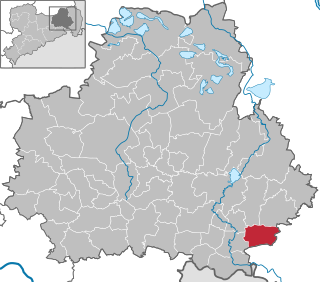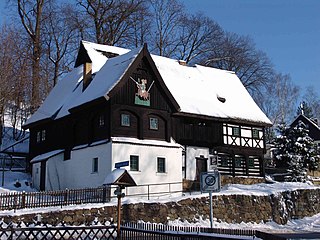
Lusatia is a historical region in Central Europe, split between Germany and Poland. Lusatia stretches from the Bóbr and Kwisa rivers in the east to the Pulsnitz and Black Elster rivers in the west, and is located within the German states of Saxony and Brandenburg as well as in the Polish voivodeships of Lower Silesia and Lubusz. Lusatia's central rivers are the Spree and the Lusatian Neisse, which constitutes the border between Germany and Poland since 1945. The Lusatian Mountains, separate Lusatia from Bohemia in the south. Lusatia is traditionally divided into Upper Lusatia and Lower Lusatia.
The district of Bautzen is a district in the state of Saxony in Germany. Its largest towns are Bautzen, Bischofswerda, Kamenz, Hoyerswerda and Radeberg. It is the biggest district in Saxony by area, and a member of the Neisse Euroregion.

Bischofswerda is a small town in Germany at the western edge of Upper Lusatia in Saxony.

Löbau is a city in the east of Saxony, Germany, in the traditional region of Upper Lusatia. It is situated between the slopes of the Löbauer Berg and the fertile hilly area of the Upper Lusatian Mountains. It is the gateway to this volcanic mountainous area and is situated halfway between the cities of Bautzen, Görlitz and Zittau.

Wehrsdorf is a small village in a valley of the Lusatian Highlands in the region of Upper Lusatia (Oberlausitz) in Saxony, Germany. It has about 1,776 inhabitants and belongs to an administrative community of three different villages, with Sohland an der Spree and Taubenheim. This community is offícially called Sohland after the largest of these villages. Altogether, the community has about 7,700 inhabitants. The village is near the border to the Czech Republic.

Bad Muskau is a spa town in the historic Upper Lusatia region in Germany, at the border with Poland. It is part of the Görlitz district in the State of Saxony.

Upper Lusatia is a historical region in Germany and Poland. Along with Lower Lusatia to the north, it makes up the region of Lusatia, named after the Slavic Lusici tribe. Both Lusatias are home to the West Slavic minority group of the Sorbs.

The Lusatian Highlands or Lusatian Hills form a hilly region in Germany and the Czech Republic. A western extension of the Sudetes range, it is located on the border of the German state of Saxony with the Czech Bohemian region. It is one of the eight natural landscapes of Upper Lusatia.

Cunewalde or in the Sorbian language Kumwałd is a municipality in the district of Bautzen in the east of the federal Free State of Saxony in Germany. It lies between the cities of Bautzen and Löbau in a valley between the hills of the Czorneboh, the Hochstein and the Bieleboh, all part of the northernmost mountain ranges of the Lusatian Highlands. It is one of the more populous villages in Upper Lusatia and the longest street village in all of Germany.

The Wesenitz is a river in Saxony, Germany, right tributary of the Elbe. Its total length is 83 km (52 mi). The Wesenitz runs through the tourist regions of the Lusatian Highlands and Saxon Switzerland. Its name is derived from Sorbian language wjaz (Elm).

Czorneboh is a mountain between Hochkirch and Cunewalde in Upper Lusatia. Czorneboh is located 10 km. from the German-Czech border north of Šluknov and 8 km. southeast of Bautzen and with an altitude of 555.7 m it is the highest point of this foothill of the Lusatian Highlands. The peak of the Czorneboh is located in the district of Meschwitz. On the top there is a mountain hostel and an observation tower.

The Hochstein is a mountain in Saxony, eastern Germany. At an elevation of 533.1 m (1,749 ft), it is the easternmost peak of the Czorneboh chain in the Upper Lusatian Highlands.

Werte der deutschen Heimat originally Werte der Deutschen Heimat and, between 1970 and 1990 called Werte unserer Heimat, was a series of publications by former East German Academy of Sciences at Berlin, that was published by Akademie-Verlag Berlin and included more than 50 volumes. The work was undertaken by the Academy’s Local History Working Group within the Institute for Geography and Geo-ecology.

The Upper Lusatian house or Umgebindehaus is a special type of house that combines log house, timber-framing and building stone methods of construction. It is especially common in the region running from Silesia through Upper Lusatia and North Bohemia and into Saxon Switzerland, as well as East Thuringia.

The Sonneberg, also called the Buchberg, is a hill in the Lusatian Highlands of eastern Germany with a height of 401.0 m above sea level (NN). It is the fourth highest hill in the borough of Neusalza-Spremberg in Saxony, after the Fuchsberg and Hahneberg and an unnamed peak about 600 metres north of the Sonneberg.

Kottmar is a municipality in the district of Görlitz, in Saxony, Germany, created with effect from 1 January 2013 by the merger of the municipalities of Eibau, Niedercunnersdorf and Obercunnersdorf. Its name derives from the Kottmar mountain.

Eastern Upper Lusatia is a natural region in Saxony and, in a broader sense, part of the Western Sudetes range including the Lower Silesian Voivodeship. The current Saxon division of natural regions view the region as part of the Saxon Loess Fields and divides it into 12 subdivisions at the level of meso-geochores.

The classification of natural regions of Saxony shown here was produced between 1994 and 2001 by a working group called "Ecosystem and Regional Character" at the Saxonian Academy of Sciences in Leipzig as part of the research and development project "Natural Regions and Natural Region Potential of the Free State of Saxony" at a scale of 1:50,000 as the basis for the rural development and regional planning. This was also supported by the Saxon State Ministry of the Environment and Agriculture and the Saxon Ministry of the Interior.

Otto Carl Alfred Moschkau (1848-1912) was a German philatelist and local historian. In 2021 he was retrospectively named as one of the fathers of philately.



















